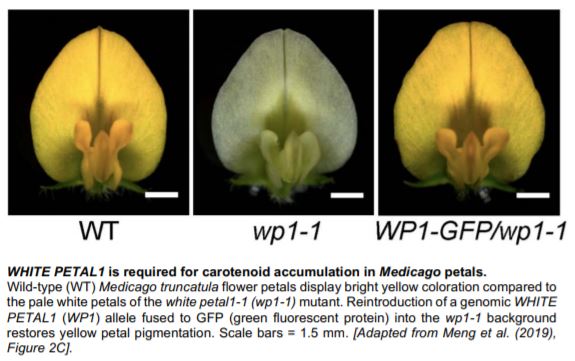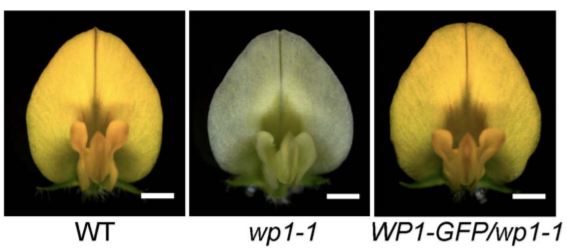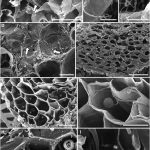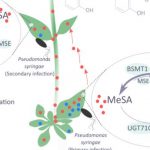Mellowed Yellow: WHITE PETAL1 Regulates Carotenoid Accumulation in Medicago Petals
Carotenoids are tetraterpenoid (C40) lipophilic compounds that are widely distributed in nature and play key roles in pigmentation, photosynthesis, and development (Nisar et al., 2015). Detailed biochemical and genetic analyses have uncovered the carotenoid biosynthetic pathway, which generates a diverse array of molecules that are either colorless or impart red (lycopene), orange (carotene), or yellow (xanthophyll) pigmentation in distantly-related photosynthetic organisms.
Despite a strong mechanistic understanding of carotenoid biosynthesis, relatively little is known about how this pathway is transcriptionally regulated (reviewed in Stanley and Yuan 2019). Insight into carotenoid regulation is provided by Meng et al. (2019), who screened Medicago truncatula insertion mutants for the loss of carotenoid-derived pigment accumulation in petals. This identified two allelic mutants, white petal1-1 (wp1-1) and wp1-2, displaying pale white petal coloration in comparison to the yellow petals of wild-type plants. Biochemical analyses confirmed that wp1 mutant petals failed to accumulate carotenoids associated with yellow pigmentation, including esterified lutein, lutein epoxide, and violaxanthin.
Molecular cloning revealed that WP1 encodes a R2R3-MYB transcription factor belonging to the subgroup 6 class of MYBs that typically regulate anthocyanin biosynthesis in flowering plants. Genetic complementation of wp1 mutants with a genomic WP1 sequence fused to GFP (green fluorescence protein) fully restored carotenoid-derived yellow pigmentation in WP1-GFP/wp1 petals (see Figure). Moreover, expression analysis demonstrated that WP1 transcripts are most abundant in floral organs, consistent with its role in floral pigment accumulation.
 To further explore the role of WP1 in Medicago, the authors assessed the expression levels of carotenoid biosynthesis genes in wp1 relative to wild-type petals. As expected, functional WP1 was required for the full extent of carotenoid biosynthesis gene expression. Further characterization of the WP1 protein revealed that its C-terminus was required for strong transcriptional activation. Next, the authors queried the promoters of WP1-dependent carotenoid biosynthesis genes for conserved MYB-binding elements to identify putative WP1 binding sites important for floral pigmentation. Using chromatin-immunoprecipitation (ChIP)-based DNA-binding experiments and heterologous transactivation assays, the authors confirmed that WP1 directly binds to the promoters of the MtLYCe (lycopene ε–cyclase) and MtLYCb (lycopene β-cyclase) carotenoid biosynthesis genes and induces their expression.
To further explore the role of WP1 in Medicago, the authors assessed the expression levels of carotenoid biosynthesis genes in wp1 relative to wild-type petals. As expected, functional WP1 was required for the full extent of carotenoid biosynthesis gene expression. Further characterization of the WP1 protein revealed that its C-terminus was required for strong transcriptional activation. Next, the authors queried the promoters of WP1-dependent carotenoid biosynthesis genes for conserved MYB-binding elements to identify putative WP1 binding sites important for floral pigmentation. Using chromatin-immunoprecipitation (ChIP)-based DNA-binding experiments and heterologous transactivation assays, the authors confirmed that WP1 directly binds to the promoters of the MtLYCe (lycopene ε–cyclase) and MtLYCb (lycopene β-cyclase) carotenoid biosynthesis genes and induces their expression.
In Medicago, several R2R3-MYBs interact with the bHLH (basic helix-loop-helix) transcription factor TRANSPARENT TESTA8 (MtTT8) and the WDR (WD-repeat domain) protein MtWD40-1, forming a MYB-bHLH-WDR (MBW) complex that regulates anthocyanin biosynthesis (Li et al., 2016). Intriguingly, both mttt8 and mtwd40-1 mutants displayed pale yellow coloration and decreased lutein levels relative to wild-type controls, which suggests that a WP1-containing MBW complex contributes to carotenoid regulation. Consistent with this idea, WP1-based DNA-binding and transactivation assays performed with and without MtTT8 and MtWD40-1 demonstrated that the presence of a WP1-MtTT8-MtWD40-1 complex results in the maximal activation of carotenoid biosynthesis. Meng and colleagues revealed an additional role for WP1-MtTT8-MtWD40-1 in regulating anthocyanin accumulation in the pigmented veins radiating from the base of the vexillum (banner) petal. Collectively, this work identifies WP1 as a key regulator of carotenoid accumulation in Medicago petals. That WP1 functions within an MWB regulatory module to control carotenoid and anthocyanin accumulation in discrete areas of the petal provides a novel framework to investigate the evolutionary history of plant secondary metabolism and floral pigmentation.
Philip Carella, Sainsbury Laboratory, University of Cambridge,
ORCID: 0000-0002-5467-7290
REFERENCES
Li P, Chen B, Zhang G, Chen L, Dong Q, Wen J, Mysore KS and Zhao J (2016) Regulation of anthocyanin and proanthocyanin biosynthesis by Medicago truncatula bHLH transcription factor MtTT8. New Phytologist 210: 905-921
Meng Y, Wang Z, Wang Y, Wang C, Zhu B, Liu H, Ji W, Wen J, Chu C, Tadege M, Niu L and Lin H (2019). The MYB activator WHITE PETAL1 associates with MtTT8 and MtWD40-1 to regulate carotenoid-derived flower pigmentation in Medicago truncatula. Plant Cell Published September 2019 DOI: https://doi.org/10.1105/tpc19.00480
Nisar N, Li L, Lu S, Khin NC and Pogson BJ (2015). Carotenoid metabolism in plants. Molecular Plant 8: 68-82
Stanley L and Yuan Y-W (2019). Transcriptional regulation of carotenoid biosynthesis in plants: so many regulators, so little consensus. Frontiers in Plant Science 10: 1017. doi: 10.3389/fpls.2019.01017




